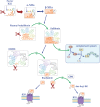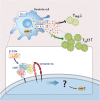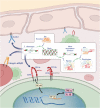The Coagulation Factors Fibrinogen, Thrombin, and Factor XII in Inflammatory Disorders-A Systematic Review
- PMID: 30105021
- PMCID: PMC6077258
- DOI: 10.3389/fimmu.2018.01731
The Coagulation Factors Fibrinogen, Thrombin, and Factor XII in Inflammatory Disorders-A Systematic Review
Abstract
Background: The interaction of coagulation factors has been shown to go beyond their traditional roles in hemostasis and to affect the development of inflammatory diseases. Key molecular players, such as fibrinogen, thrombin, or factor XII have been mechanistically and epidemiologically linked to inflammatory disorders like multiple sclerosis (MS), rheumatoid arthritis (RA), and colitis.
Objectives: To systematically review the evidence for a role of coagulation factors, especially factor XII, fibrinogen, and thrombin in inflammatory disorders like MS, RA, and bowel disorders.
Methods: A systematic literature search was done in the PubMed database to identify studies about coagulation factors in inflammatory diseases. Original articles and reviews investigating the role of the kallikrein-kinin and the coagulation system in mouse and humans were included.
Results: We identified 43 animal studies dealing with inflammatory disorders and factors of the kallikrein-kinin or the coagulation system. Different immunological influences are described and novel molecular mechanisms linking coagulation and inflammation are reported.
Conclusion: A number of studies have highlighted coagulation factors to tip the balance between hemostasis and thrombosis and between protection from infection and extensive inflammation. To optimize the treatment of chronic inflammatory disorders by these factors, further studies are necessary.
Keywords: coagulation factors; contact system; factor XII; fibrinogen; neuroinflammation; thrombin.
Figures




References
Publication types
MeSH terms
Substances
LinkOut - more resources
Full Text Sources
Other Literature Sources

